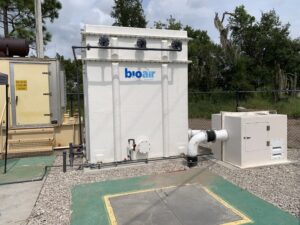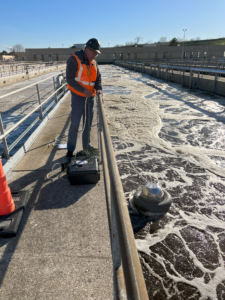Innovative Technologies for Primary Clarifier Odor Control: WEA’s Cutting-Edge Approach
 Staying ahead with innovative technologies is essential in the field of odor control. As the first stage in the wastewater treatment process, primary clarifiers play a critical role in managing odors before they can impact the surrounding environment and communities. At Webster Environmental Associates, Inc. (WEA), we recognize the importance of implementing advanced solutions for primary clarifier odor control. Our commitment to using the latest technologies ensures that we can effectively manage odors at the source, improving both the efficiency and sustainability of wastewater treatment plants.
Staying ahead with innovative technologies is essential in the field of odor control. As the first stage in the wastewater treatment process, primary clarifiers play a critical role in managing odors before they can impact the surrounding environment and communities. At Webster Environmental Associates, Inc. (WEA), we recognize the importance of implementing advanced solutions for primary clarifier odor control. Our commitment to using the latest technologies ensures that we can effectively manage odors at the source, improving both the efficiency and sustainability of wastewater treatment plants.
The Role of Innovation in Managing Odors at the Source
Managing odors at the source, particularly in primary clarifiers, is crucial for preventing issues down the line. Traditional methods of odor control can be effective, but advancements in technology have opened up new possibilities for more efficient and sustainable solutions. By addressing odors directly at the primary clarifier stage, we can reduce the load on subsequent treatment processes and minimize the risk of odors escaping into the environment.
Innovation in odor control technology allows us to target specific odor-causing compounds more precisely and efficiently. This targeted approach not only improves the overall effectiveness of odor management but also reduces the need for reactive measures later in the treatment process. At WEA, we focus on integrating these advanced technologies into our clients’ operations to ensure that odors are managed proactively and efficiently.
WEA’s Cutting-Edge Technologies for Primary Clarifier Odor Control
At WEA, we employ a range of cutting-edge technologies to manage odors in primary clarifiers. Our real-time monitoring tools are a cornerstone of our approach. These tools continuously measure odor levels, allowing us to detect and address issues as they arise. By providing immediate data, real-time monitoring enables us to take swift action, ensuring that odors are controlled before they can become problematic.
In addition to monitoring, we use biofilters and biotrickling scrubbers as key components in our odor control strategy. Biofilters utilize naturally occurring microorganisms to break down odor-causing compounds as the air passes through a bed of organic media. This process is highly effective at treating odors from primary clarifiers and is an eco-friendly solution that reduces the need for chemical treatments.
Biotrickling scrubbers work similarly but use a trickling liquid phase to enhance the biological degradation of odors. This method is particularly useful for treating high concentrations of odorous gases, such as hydrogen sulfide, that are common in wastewater treatment. Together, biofilters and biotrickling scrubbers provide a robust and sustainable approach to controlling odors at the source, improving air quality while supporting the efficiency of the treatment process.
We also utilize UV oxidation and ionization systems as part of our odor control strategy. UV oxidation is highly effective in neutralizing odor-causing compounds, such as hydrogen sulfide, before they can escape the clarifier. Ionization systems work by generating ions that interact with odor molecules, breaking them down into harmless substances. These technologies are powerful tools in our arsenal, providing a robust defense against the complex odors generated during the wastewater treatment process.
Integrating New Technologies into Existing Systems
One of the key strengths of WEA’s approach is our ability to seamlessly integrate new technologies into existing odor control systems. Many wastewater treatment plants operate with established systems that, while effective, may benefit from technological upgrades. We specialize in retrofitting and enhancing these systems with state-of-the-art technologies, improving their performance without disrupting ongoing operations.
Upgrading older systems with modern technology offers several benefits. First, it enhances the efficiency of industrial odor control, ensuring that even the most challenging odors are managed effectively. Second, it extends the lifespan of existing infrastructure, reducing the need for costly replacements. Finally, it ensures that facilities remain compliant with evolving environmental regulations, which increasingly demand the use of advanced, sustainable technologies.
Our team works closely with clients to assess their current systems and identify opportunities for improvement. Whether it’s integrating real-time monitoring tools, automating controls, or adding advanced odor neutralization technologies, we provide solutions that are tailored to the unique needs of each facility.
The Future of Odor Control in Wastewater Treatment
 The field of odor control is constantly evolving, with new technologies and methods emerging regularly. At Webster Environmental Associates, Inc., we are committed to staying at the forefront of these developments. We believe that continuous improvement is essential for maintaining the highest standards of odor control and ensuring the long-term success of wastewater treatment facilities.
The field of odor control is constantly evolving, with new technologies and methods emerging regularly. At Webster Environmental Associates, Inc., we are committed to staying at the forefront of these developments. We believe that continuous improvement is essential for maintaining the highest standards of odor control and ensuring the long-term success of wastewater treatment facilities.
Looking to the future, we anticipate further advancements in areas such as real-time data analytics, enhanced monitoring systems, and more efficient odor neutralization technologies. As these innovations become available, we will continue to incorporate them into our solutions, ensuring that our clients benefit from the latest and most effective tools.
Our focus on innovation is not just about adopting new technologies; it’s about continually refining our approach to ensure that we provide the best possible service. We understand that each facility faces unique challenges, and we are dedicated to finding the most effective solutions for managing those challenges.
Partner with WEA for Innovative Primary Clarifier Odor Control
Effective odor control in primary clarifiers is essential for the overall success of wastewater treatment operations. At WEA, our innovative approach to managing odors ensures that our clients can operate their facilities efficiently, sustainably, and in compliance with environmental regulations. By leveraging the latest technologies and continuously seeking out new advancements, we help our clients stay ahead in the ever-evolving field of odor control.
If you’re looking to enhance your facility’s odor control capabilities, we invite you to contact us at WEA. Our team of experts is ready to help you integrate cutting-edge solutions that will optimize your operations and protect the surrounding environment. Let us work with you to achieve the highest standards of primary clarifier odor control.
